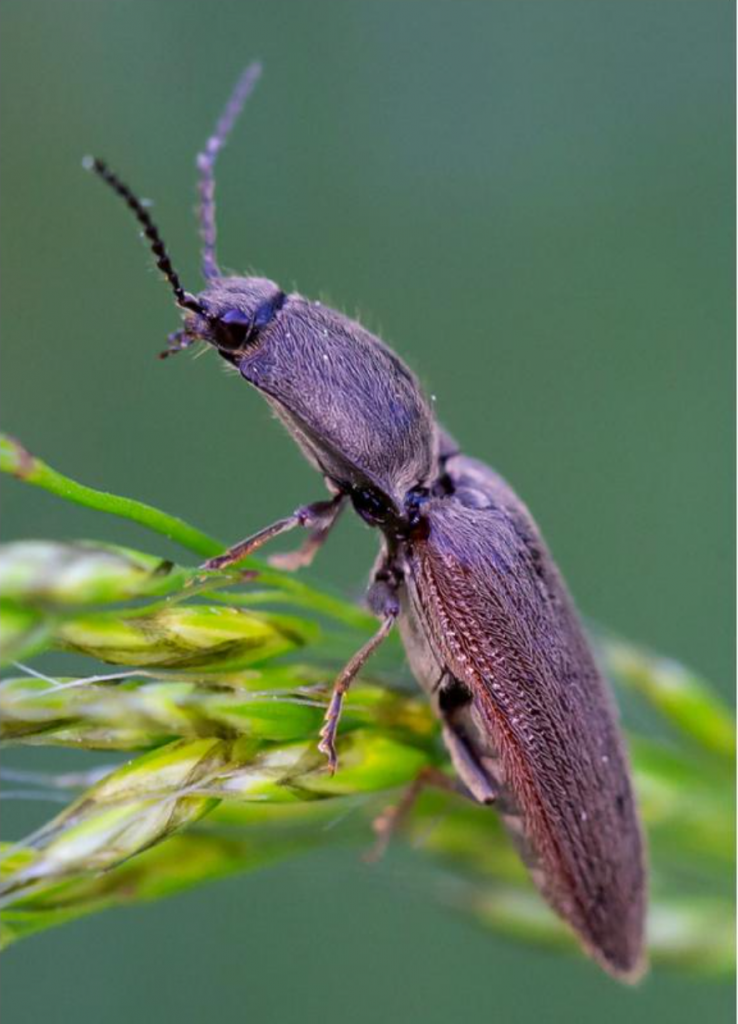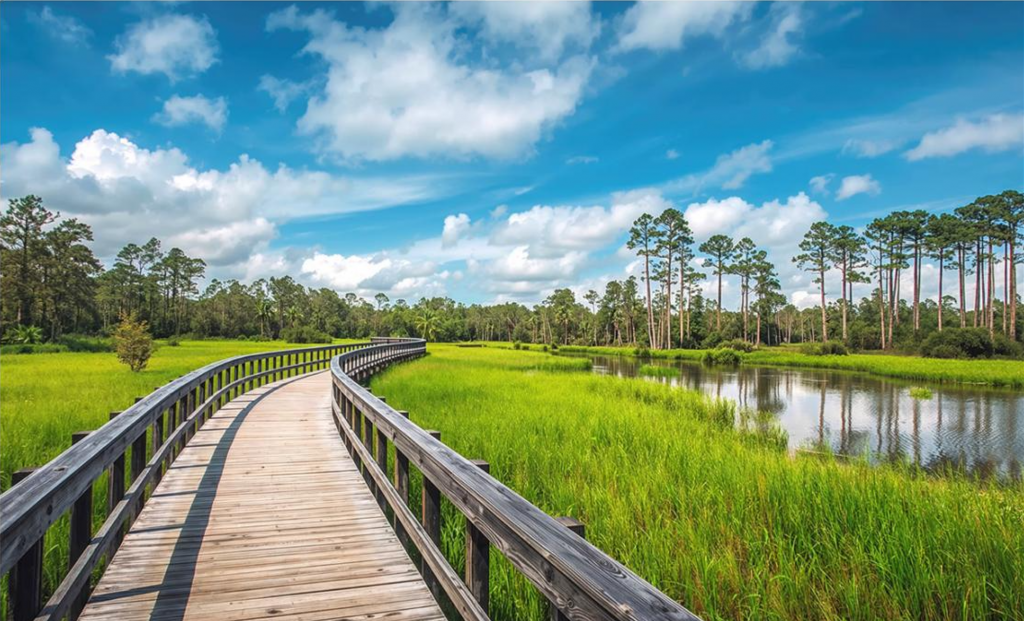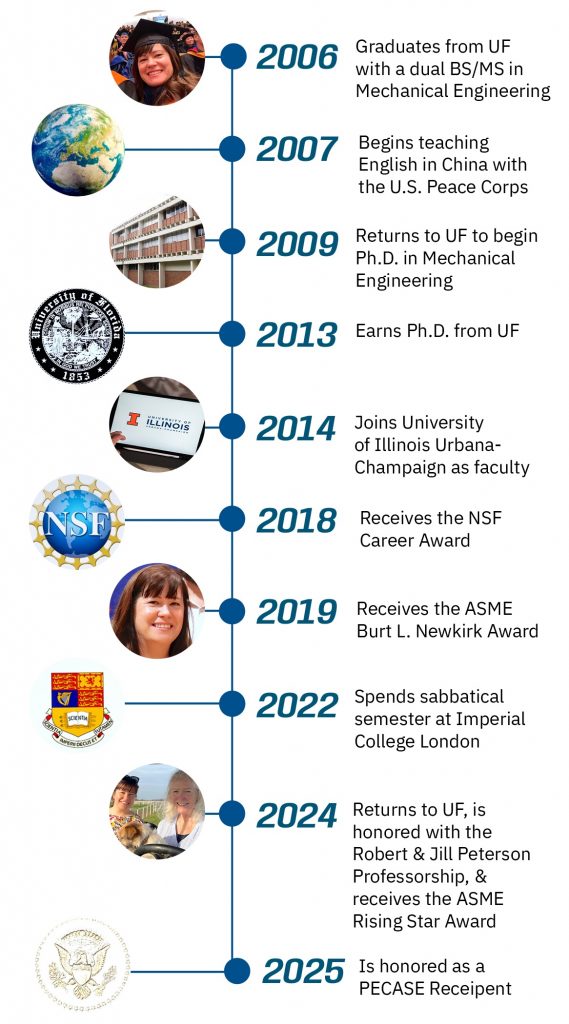Triple Gator, trailblazer and PECASE recipient. Alison Dunn makes UF MAE proud with her curiosity, mentorship, and innovation. Scroll through this exclusive MAE Momentum feature, to see how she’s shaping engineering, one surface at a time.
Engineering For The Body:
Biomedical research that bridges surfaces, sensation, and human-centered design.
Alison Dunn Ph.D. makes surfaces behave. It’s not magic—it’s mechanics. Through her work in tribology, she explores friction, wear, and lubrication to better understand how materials move and interact. Her ultimate goal? To define the design rules for soft materials, especially those used in biomedical devices like contact lenses and artificial joints—materials that need to feel like they belong in the body.
Dunn describes her research in simple terms: “I make surfaces behave the way we want them to.” Her lab focuses on soft, water-based gels, called hydrogels, that can be engineered to feel right when in contact with the human body. That “feel” isn’t just about comfort; it’s a critical aspect of biomedical compatibility. Her team studies how to tune properties like water content, surface structure, porosity, and deformation to control how a surface feels when something slides against it.
This work holds promise for a wide range of applications— from soft contact lenses to heart valves, artificial joints and other devices that interface directly with human tissue. Dunn sees the broader purpose in all of it: building the knowledge that will allow others to design safer, more effective technologies.

One of her current projects, in collaboration with Shelby Hutchens at UIUC, explores the mechanical experience of inserting a needle through layered materials—an everyday but complex task in medical procedures. To better understand this interaction, Dunn’s team uses soft synthetic models that mimic the behavior of biological tissues. They measure how much effort is needed to advance a needle through these materials and how surface interactions influence that motion. By studying both the resistance to entry and the friction along the surface, they’re building a more complete picture of how tools interact with soft matter.
The next phase of the project involves using microscopy to observe these interactions at a fine scale, helping the team understand how material structure and movement influence one another. The goal is to develop predictive models that can anticipate the tactile feedback a practitioner or robotic system might encounter—turning a traditionally intuitive process into one grounded in measurable mechanics.
This research could enhance medical training by helping clinicians understand what to expect when navigating complex tissue environments. It also holds promise for improving robotic needle systems, allowing them to respond more intelligently to subtle changes in material properties. Instead of relying solely on force sensors, these systems could be guided by a mechanical “map” of expected feedback, improving precision and safety.
“I want to create new fundamental design rules,” she explains. “We don’t yet have a handbook for soft materials the way we do for engineering materials. I’m hoping to help write that someday.
Beyond The Body
While much of Dunn’s work focuses on biomedical applications, her passion for tribology extends far beyond the human body. At its core, her research explores how surfaces move and interact, a question that spans biology, robotics, and even mechanisms in space.
“Once you start thinking about friction, you see it everywhere. It’s in how we move, how machines operate, how animals jump, grip, or glide.”
That curiosity led her lab to draw inspiration from an unexpected source: the click beetle. Led by her first Ph.D. student, Nabin Bastola, the project investigates how these small insects use a latching mechanism to store and explosively release energy, propelling themselves into the air.
The team studies how friction governs the motion of the latch, with an eye toward replicating the mechanism in robotics or space systems that require rapid mechanical motion without complex power sources.
“It’s a great example of how biology can inspire better engineering. We’re imagining uses in deserts or space, anywhere you need fast deployment without a lot of machinery.”
This work could inform low-power, high efficiency systems for planetary exploration, disaster response, or remote sensing. Bastola has already built a latching friction tester to study the mechanics in detail and is leading the experimental work as part of his doctoral research. Bastola’s work reflects the kind of curiosity Dunn has nurtured throughout her career—one that began with a promise, a pivot, and a mentor who saw her potential early on.

A Promise & A Pivot:
“You’ll be back.” Dunn didn’t believe Dr. Greg Sawyer, her undergraduate research advisor and longtime mentor, when he said those words years ago. She was finishing her bachelor’s and master’s degrees in mechanical engineering at UF and preparing to leave for a Peace Corps assignment in China. “I swore I wouldn’t,” she remembers. “But he knew.”
Two years later, while teaching English overseas, Dunn realized just how much she missed research, and how much she loved teaching. She emailed Sawyer: “You were right.” He welcomed her back into his lab, and she began her Ph.D. in 2008. Her research flourished, spanning hydrogels for soft contact lenses, friction in bulk polymers, and even lubrication of living tissues. Along the way, she navigated the dual challenges of graduate school and new motherhood with Sawyer’s encouragement helping her find her stride.
“I aimed for academia,” Dunn says. “Not with a rigid goal, but with the intention to give it my all.”
Palm & Pine vs. Corn & Soybeans
After completing her doctorate in 2013, Dunn taught at UF as a teaching fellow, then landed a faculty position at the University of Illinois Urbana-Champaign. She spent nearly a decade there, launching her own research program and mentoring students. But she never lost her Gator spirit.
“We grew deep roots at Illinois, but UF remained dear to us. We watched every football game from Illinois and stayed connected to Gainesville from afar.”
Even miles away, she and her husband maintained a special connection to Gainesville, signing up for the SEC Network, tuning into games, and holding on to fond memories of the South and the swamp.
When she heard that Sawyer was stepping away from UF, she reached out—curious whether the department was looking for someone to build on the work they had shared. That led to a conversation with Dr. Warren Dixon and, eventually, an opportunity she couldn’t pass up. Dunn returned to UF MAE in 2024.

Mentorship & Motivation
Dunn’s lab is growing quickly, with students from diverse technical backgrounds and academic levels. Many presented at the Society of Tribologists and Lubrication Engineers (STLE) annual meeting in 2025, an event Dunn has attended since 2005.
She’s committed to teaching as much as research. “I love helping students build their engineering intuition,” she says. “Not just solving problems, but understanding how to
think like engineers.”
Her Ph.D. student Nabin Bastola, originally from Nepal, says working with Dunn has been both technically enriching and personally meaningful.
“Dr. Dunn has played a pivotal role in my growth as a researcher by encouraging me to be open and communicative. Last semester, she motivated me to participate in the STLE Tribology Conference, where I was able to share my research ideas effectively and learn from the work of others. She is always willing to provide resources and opportunities that foster my development, while also emphasizing the importance of interdisciplinary collaboration and critical thinking.” -Nabin Bastola
Leading with Purpose
This year, Dunn received one of the most prestigious honors in the country for early-career researchers: the Presidential Early Career Award for Scientists and Engineers (PECASE). Presented by the White House, the award recognizes scientists and engineers at the frontiers of innovation and community impact. Dunn was nominated by the National Science Foundation for her pioneering work in tribology and her deep commitment to mentoring students.
The award affirms the significance of her research on surfaces and materials, which directly impacts technologies ranging from biomedical devices to robotics. It also connects her to a national network of scientists working to advance both science and society.
For Dunn, the recognition brings renewed energy and a sense of responsibility to continue mentoring, asking bold questions, and contributing to the field. It marks a milestone in a journey that began in Gainesville, stretched around the globe, and ultimately led her back to UF.
In addition to receiving the PECASE in 2025, Dunn has earned several other prestigious recognitions for her contributions to tribology and engineering education. She was awarded the NSF CAREER Award in 2018, the ASME Burt L. Newkirk Award in 2019, and was named a 2024 Rising Star by the Academy of Science, Engineering, and Medicine of Florida (ASEM-FL). She also holds the Robert and Jill Peterson Professorship, a position that supports the continued growth of her research program at UF.
At home in Gainesville, Dunn and her family live close to campus and enjoy being part of the local culture. They recently added a black lab puppy to the mix and spend their free time visiting coffee shops, attending UF events, and riding bicycles around town. She is grateful to be rooted in the place where it all began, a place that continues to inspire her work and her outlook.
“I try to focus on what I can do,” Dunn says. “There are always challenges: funding, tenure pressures, the unknowns. But I believe in the work, and in the good it can do.”
Triple Gator to PECASE


